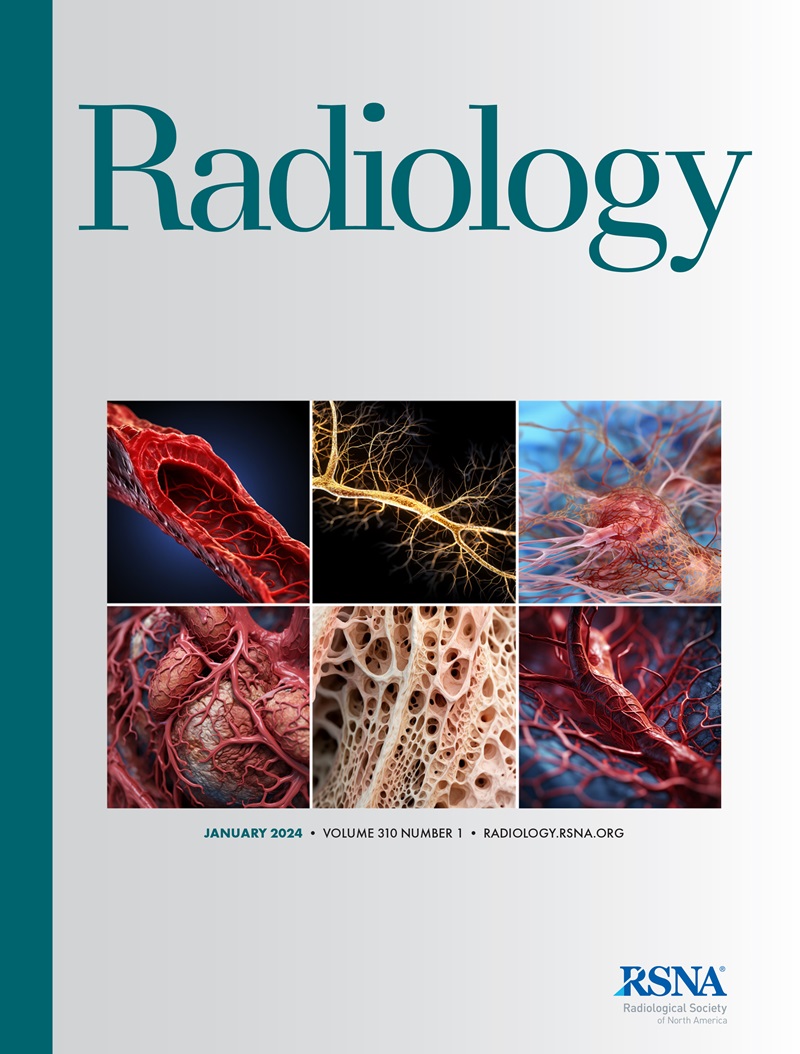Lea Mantz, Nathaniel D Mercaldo, Judit Simon, Philipp Kaess, Kai Yang, Anna-Sophia W Dietrich, P Erik Tonnesen, Amelie S Troschel, J Peter Marquardt, Daniel A Sehi, Cylen Javidan, Jonathan H Chung, Henning A Gaissert, Mark K Ferguson, Florian J Fintelmann
求助PDF
{"title":"Preoperative Chest CT Myosteatosis Indicates Worse Postoperative Survival in Stage 0-IIB Non-Small Cell Lung Cancer.","authors":"Lea Mantz, Nathaniel D Mercaldo, Judit Simon, Philipp Kaess, Kai Yang, Anna-Sophia W Dietrich, P Erik Tonnesen, Amelie S Troschel, J Peter Marquardt, Daniel A Sehi, Cylen Javidan, Jonathan H Chung, Henning A Gaissert, Mark K Ferguson, Florian J Fintelmann","doi":"10.1148/radiol.240282","DOIUrl":null,"url":null,"abstract":"<p><p>Background Skeletal muscle density (SMD) and intermuscular adipose tissue (IMAT) are myosteatosis markers. The prognostic value of myosteatosis markers in preoperative risk stratification of patients with early-stage non-small cell lung cancer (NSCLC) remains unknown. Purpose To assess whether increased myosteatosis markers at chest CT before lung resection of early-stage NSCLC are associated with and predictive of worse overall survival (OS). Materials and Methods This retrospective cohort study included patients with stage 0-IIB NSCLC who underwent lobectomy or bilobectomy at three hospitals between 2014 and 2017. The indexes (cross-sectional area [in centimeters squared] divided by height [in meters squared]) and densities (mean attenuation [in Hounsfield units]) of skeletal muscle, subcutaneous adipose tissue (SAT), and IMAT were assessed at CT at the level of the 12th thoracic vertebral body via semiautomated threshold-based segmentation. Associations of SMD and the IMAT index with OS were evaluated via separate Cox proportional hazards models adjusted for skeletal muscle index, SAT index, SAT density, and relevant confounders. The ability of indexes and densities to predict OS was explored with penalized Cox proportional hazards models and internally validated concordance statistics. Results Among 838 patients (median age, 68 years [IQR, 61-74 years]; 475 [56.7%] female patients), 219 died after a median follow-up of 5.3 years (IQR, 3.0-6.4 years). Increased myosteatosis, represented by decreased SMD and an increased IMAT index, was associated with worse OS (adjusted hazard ratio, 0.87 [95% CI: 0.80, 0.93]; <i>P</i> < .001 and adjusted hazard ratio, 1.24 [95% CI: 1.12, 1.37]; <i>P</i> < .001, respectively). There was no evidence of an association between OS and skeletal muscle index, SAT index, and SAT density. The predictive performance (concordance) increased from 0.723 (95% CI: 0.686, 0.753) to 0.731 (95% CI: 0.692, 0.762) after including myosteatosis markers. Conclusion Increased thoracic myosteatosis markers were associated with worse OS after lobectomy or bilobectomy of stage 0-IIB NSCLC, independent of skeletal muscle index, SAT index, and SAT density, and improved OS prediction. © RSNA, 2025 <i>Supplemental material is available for this article.</i></p>","PeriodicalId":20896,"journal":{"name":"Radiology","volume":"314 2","pages":"e240282"},"PeriodicalIF":12.1000,"publicationDate":"2025-02-01","publicationTypes":"Journal Article","fieldsOfStudy":null,"isOpenAccess":false,"openAccessPdf":"","citationCount":"0","resultStr":null,"platform":"Semanticscholar","paperid":null,"PeriodicalName":"Radiology","FirstCategoryId":"3","ListUrlMain":"https://doi.org/10.1148/radiol.240282","RegionNum":1,"RegionCategory":"医学","ArticlePicture":[],"TitleCN":null,"AbstractTextCN":null,"PMCID":null,"EPubDate":"","PubModel":"","JCR":"Q1","JCRName":"RADIOLOGY, NUCLEAR MEDICINE & MEDICAL IMAGING","Score":null,"Total":0}
引用次数: 0
引用
批量引用
Abstract
Background Skeletal muscle density (SMD) and intermuscular adipose tissue (IMAT) are myosteatosis markers. The prognostic value of myosteatosis markers in preoperative risk stratification of patients with early-stage non-small cell lung cancer (NSCLC) remains unknown. Purpose To assess whether increased myosteatosis markers at chest CT before lung resection of early-stage NSCLC are associated with and predictive of worse overall survival (OS). Materials and Methods This retrospective cohort study included patients with stage 0-IIB NSCLC who underwent lobectomy or bilobectomy at three hospitals between 2014 and 2017. The indexes (cross-sectional area [in centimeters squared] divided by height [in meters squared]) and densities (mean attenuation [in Hounsfield units]) of skeletal muscle, subcutaneous adipose tissue (SAT), and IMAT were assessed at CT at the level of the 12th thoracic vertebral body via semiautomated threshold-based segmentation. Associations of SMD and the IMAT index with OS were evaluated via separate Cox proportional hazards models adjusted for skeletal muscle index, SAT index, SAT density, and relevant confounders. The ability of indexes and densities to predict OS was explored with penalized Cox proportional hazards models and internally validated concordance statistics. Results Among 838 patients (median age, 68 years [IQR, 61-74 years]; 475 [56.7%] female patients), 219 died after a median follow-up of 5.3 years (IQR, 3.0-6.4 years). Increased myosteatosis, represented by decreased SMD and an increased IMAT index, was associated with worse OS (adjusted hazard ratio, 0.87 [95% CI: 0.80, 0.93]; P < .001 and adjusted hazard ratio, 1.24 [95% CI: 1.12, 1.37]; P < .001, respectively). There was no evidence of an association between OS and skeletal muscle index, SAT index, and SAT density. The predictive performance (concordance) increased from 0.723 (95% CI: 0.686, 0.753) to 0.731 (95% CI: 0.692, 0.762) after including myosteatosis markers. Conclusion Increased thoracic myosteatosis markers were associated with worse OS after lobectomy or bilobectomy of stage 0-IIB NSCLC, independent of skeletal muscle index, SAT index, and SAT density, and improved OS prediction. © RSNA, 2025 Supplemental material is available for this article.

 求助内容:
求助内容: 应助结果提醒方式:
应助结果提醒方式:


